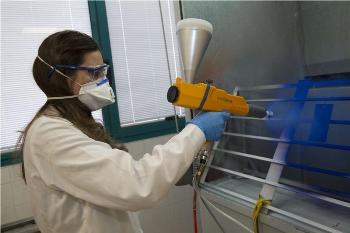Feb 19 2013
Researchers at the Universitat Jaume I de Castellón (Spain) are working on a new type of coating that provides higher protection against metal corrosion due to its improved adherence to the metal surface and its anti-corrosion properties. The novelty resides in the elements used in the treatment of the paints through three chemically different pathways and the synergistic effect they produce. When the components interact, adherence of the paint to the metal substrate increases and anticorrosive properties improve. This way, the new coatings offer, with a single layer, a protection as good as when a pre-treatment is used.
 Painting process
Painting process
So far the option the industry had to protect metals against corrosion has always required an initial print or pre-treatment that involves, in most cases, on the one hand metal cleaning and corrosion or on the other adding another paint layer.
The idea of the project, says researcher José Javier Gracenea, "is to avoid this pre-treatment and remove a production stage and all that comes with it in terms of time and money, since the metal preparation always involves an additional phase and expensive".
The new coating is applicable to all metals, although, according to Gracenea, "we are currently working with aluminium, steel and galvanized steel as they mean 99% of industrial metals used. For example, aluminium is used for all types of metal work, steel is present in most appliances and galvanized steel is chosen for manufacturing poles or lampposts."
The project has been developed within Impact, the call of the Spanish Ministry of Economics and Competitiveness that seeks to promote cooperation between companies and research centres. Thus, from the needs the market detects, universities outline a number of products that may be of interest to companies in order to market them afterwards.
In this case, the company with which the Universitat Jaume I works is Mediciones y Corrosión (Medco), located in Espaitec, the University's Science and Technology Park.
It is expected this new type of paint to be on the market within two years, and its use will save around 20% in production costs, which is important when talking about high volumes of production.